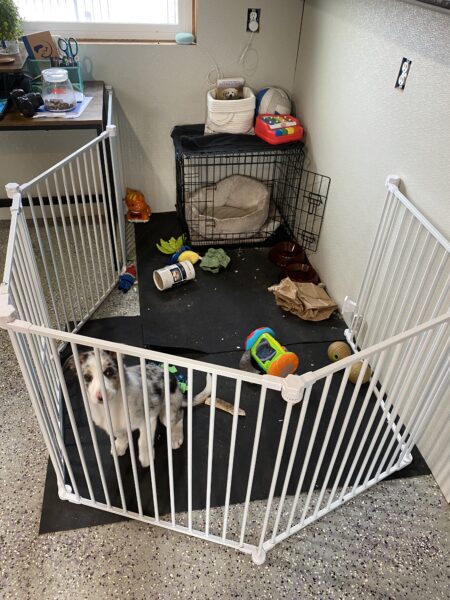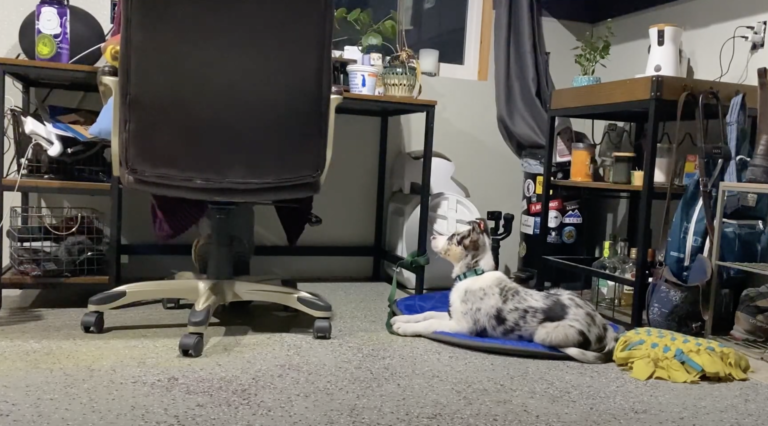Let’s face it: puppies can be super annoying. As I write this, my 12-week-old border collie is whining behind me from his gated off “Puppy Palace” (actually, a corner of my 300-square-foot cottage). He’s been whining for about 10 minutes, but it feels like hours. I KNOW he needs a nap – he just played for an hour, he ate two hours ago, he’s been to the bathroom twice… but he doesn’t want to nap yet.
The point is, puppies are almost as annoying as they are cute. I get that! That’s where different levels of management come in for dog training. I honestly couldn’t survive puppy-raising without management.
As I said, Niffler the puppy is currently in his “Puppy Palace,” which consists of a pet gate that I have locked into position to section off a corner of my cottage. He’s got a crate in there with a cozy bed, some water, plenty of squeaky toys, and some puppy-safe shreddable and chewable toys.
But as your puppy ages, you might want to start to graduate your puppy out of the Puppy Palace and integrate them into the rest of your household. Or perhaps your house is large and multi-level where a Puppy Palace isn’t practical because your puppy feels so scared and alone on the first floor if you’re up on the third.

Either way, you might be ready to try the tether method of puppy raising. This is also called the “umbilical method” of puppy raising, and you’ll see why in a moment.
What is Tether Training for Puppies?
Tether training is using a leash (or metal cord leash for heavy chewers) to tie your puppy to you or a piece of furniture. This allows you to keep a close eye on your puppy while still teaching your puppy how to handle more freedom than a Puppy Palace or crate provides.
Tether training is a bit tricky. Most families have the most success if they use a Puppy Palace in the beginning and slowly transition to tether training and eventually letting their puppy roam free.
To be successful, you should start tether training when your puppy is already pretty relaxed. Don’t try to tie her to your desk when she’s riled up and ready to PLAY (or overly-tired and wanting to bite everything in sight).
Have some treats or your puppy’s kibble ready so that you can reward her for good choices. I use the SMART x 50 framework here. Every time I See my puppy do something I like, I Mark (say “yes”) And Reward for Training (SMART). I try to do this 50 times per day.
Here’s a brief video of me doing this with Niffler – this is his very first time being tethered! You’ll hear that I say “yes” and feed him when he settles. This is a clip out of a 20 minute session – then I put him away in his Puppy Palace with a bully stick for a real nap.
If Niffler had gotten antsy or upset, I would have simply taken him outside for a quick and boring potty break, then placed him in his Puppy Palace for a nap – no big deal!
Over time, the goal is to tether your puppy in more places so that you can keep an eye on them and teach them to behave nicely all around your house. You can prevent all sorts of problem behaviors using tether training!
How Can Tether Training Help With Puppy Problems?
It’s important to note that tether training is about prevention. Your job is still to be a good, gentle trainer!
Rather than using the tether to yank your puppy around or reel them in to punish them, you still need to focus on rewarding your puppy for good choices and gently redirecting them if they’re straying.
A tethered puppy is trapped, and if you use that power to scare or startle your puppy it will only make your puppy distrust you!
- Chewing. While your puppy absolutely can still chew while tethered to you, you are in a position to gently interrupt them and redirect them onto a more appropriate chewtoy. If your puppy is tethered to you or your couch and starts to gnaw on the coffee table, you can gently move them away using the tether and then offer them an antler, buffalo horn, bully stick, or Kong. You won’t have to chase your puppy around the house, which can either scare them or teach them that chewing is a great way to start a fun game of chase.
- Jumping on guests. If your puppy jumps on you, tethering won’t help. But if their main issue is jumping up on others, a tether helps you physically prevent your puppy from jumping up. If your puppy is tied to your waist, you gently guide them away from visitors until your puppy is a bit calmer, then allow them to greet each other politely.
- Potty Training. If your puppy is tethered to you, it’s much harder for you to miss signs that they need to go. If you notice your puppy sniffing, circling, or squatting, you are able to easily scoop them up and rush outside. Tether training prevents your puppy from sneaking away to relieve themselves in a quiet corner. If you’re distracted enough by cooking or watching the big game that you’ll still miss your puppy’s signs of needing to go, it’s best to put the puppy in the Puppy Palace.
- Crate and Alone Issues. If your puppy simply isn’t ready to hang out alone in their Puppy Palace, you can use a tether to help your puppy feel safe (not alone) while still keeping your possessions safe from sharp puppy teeth. Of course, you still want to teach your puppy to be alone for grocery trips. But tether training is a great way to meet your puppy’s needs while you work out a crate training plan.
- NOT Great for Nipping. If your puppy tends to bite at you a lot, tether training isn’t a great option. You can still tether your puppy to a piece of furniture out of reach from you, but overall this method isn’t great for nipping or jumping that’s directed at you.
Please know that tether training is an intermediate or advanced management tool. A well-set-up and well-placed Puppy Palace is much easier for you to use and may be a better choice for most people.
I’m a professional trainer, and I still mostly rely on my Puppy Palace. My goal with tether training is to slowly graduate Niffler from the Puppy Palace –> tether training –> freedom over the next six months or so. I don’t expect to be able to trust him loose in my cottage until he’s AT LEAST six or eight months old.
Tether training can frustrate your puppy or escalate situations if used poorly. If you find that your puppy is upset or “acting up” when tethered, you may need to go back to the drawing board or get help from a trainer. I recommend using the Pandemic Puppy Raising Group on Facebook for help until you can hire a trainer.
As I mentioned above, tether training is best used when paired with SMART x 50. Check out that article for more information!


I need help with a rescue dog
Potty training
Drinking water
Hi Debi, you can book a session with one of our trainers in the menu above.